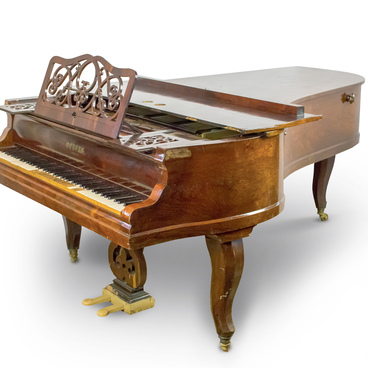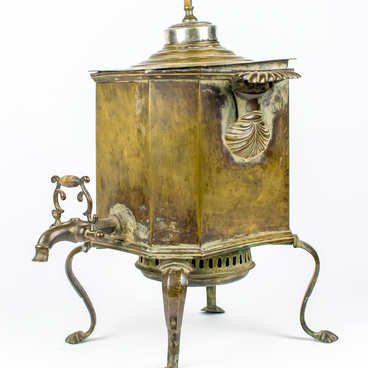This ring has an irregularly shaped bevelled cylinder shape and is made of silver. The ring’s entire surface is decorated with a floral design.
A napkin ring is a dinner-table serving piece and is put on a rolled-up napkin. Besides circular rings, there are also oval, rectangular, triangular, hexagonal, and ornately-shaped rings.
In England in the 18th century, the rings were used to indicate clean napkins. Thus, it was possible to specify which napkin could be used at lunch, and which required washing. Later, the rings were used to indicate which napkin belonged to which member of the family. Each person had their own napkin and their own ring decorated with the owner’s monogram.
Such napkin holders appeared in France at the beginning of the 19th century. At that point in time, silver rings had lost their actual use and by the forties of the 19th century in Europe, they became very popular as a serving piece and table decor. In order to get a fashionable table requisite, some citizens gave for smelting down silver coins, from which rings were made.
The rings could be closed or split, and with flat, convex, or edge surfaces. Some napkin rings had small legs with balls or widenings at the ends in the form of animal or bird paws.
The napkin ring diameter usually made up 35-45 millimeters, the width was 30-40 millimeters, and the item’s weight was about 40-50 grams. Aside from silver, the rings were made of cupronickel, brass, copper, nickel-silver, organic glass, wood, porcelain, nacreshell, bone, and horn.
The napkin ring monograms and markings were carved out or engraved depending on the material. The metal napkin rings, were made traceried and solid, the latter were decorated with chasing work, engraving, niello, enamel and filigree. Brass, copper and nickel-silver rings were plated with silver and nickel. The wooden items were decorated with colored pictures.
A napkin ring is a dinner-table serving piece and is put on a rolled-up napkin. Besides circular rings, there are also oval, rectangular, triangular, hexagonal, and ornately-shaped rings.
In England in the 18th century, the rings were used to indicate clean napkins. Thus, it was possible to specify which napkin could be used at lunch, and which required washing. Later, the rings were used to indicate which napkin belonged to which member of the family. Each person had their own napkin and their own ring decorated with the owner’s monogram.
Such napkin holders appeared in France at the beginning of the 19th century. At that point in time, silver rings had lost their actual use and by the forties of the 19th century in Europe, they became very popular as a serving piece and table decor. In order to get a fashionable table requisite, some citizens gave for smelting down silver coins, from which rings were made.
The rings could be closed or split, and with flat, convex, or edge surfaces. Some napkin rings had small legs with balls or widenings at the ends in the form of animal or bird paws.
The napkin ring diameter usually made up 35-45 millimeters, the width was 30-40 millimeters, and the item’s weight was about 40-50 grams. Aside from silver, the rings were made of cupronickel, brass, copper, nickel-silver, organic glass, wood, porcelain, nacreshell, bone, and horn.
The napkin ring monograms and markings were carved out or engraved depending on the material. The metal napkin rings, were made traceried and solid, the latter were decorated with chasing work, engraving, niello, enamel and filigree. Brass, copper and nickel-silver rings were plated with silver and nickel. The wooden items were decorated with colored pictures.



